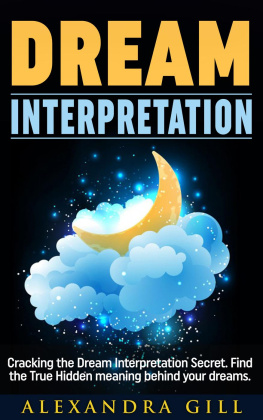Energy Psychology Press
Santa Rosa, CA 95404
www.energypsychologypress.com
Library of Congress Cataloging-in-Publication Data
Hoss, Robert and Lynne.
Dream to Freedom : handbook for integrative dreamwork and energy psychology / by Robert and Lynne Hoss 1st ed.
p. cm.
Includes bibliographical references.
ISBN: 978-1-60415-200-5
1. Dream interpretation. 2. Energy psychology. 3. Emotional Freedom Techniques. I. Hoss, Lynn. I. Title.
BF1078.H747 2013
154.63dc23
2013004235
Copyright 2013, Robert and Lynne Hoss
All rights reserved. No part of this publication may be reproduced, stored in a retrieval system, or transmitted in any form or by any means, electronic, mechanical, photocopy, recording, or otherwise, without prior written permission from Energy Psychology Press, with the exception of short excerpts used with acknowledgement of publisher and author.
Cover design by Victoria Valentine
Typesetting by Karin Kinsey
Editing by Stephanie Marohn
Typeset in Adobe Garamond Pro and Eva
Printed in USA
First Edition
10 9 8 7 6 5 4 3 2 1
Important Disclaimer
While EFT (Emotional Freedom Techniques) has produced remarkable clinical results, it must still be considered to be in the experimental stage and thus practitioners and the public must take complete responsibility for their use of it. Further, the authors offer the information in this book solely as their opinion. Readers are strongly cautioned and advised to consult with a physician, psychologist, psychiatrist, or other licensed health care professional before utilizing any of the information in this book. The information is from sources believed to be accurate and reliable and every reasonable effort has been made to make the information as complete and accurate as possible but such completeness and accuracy cannot be guaranteed and is not guaranteed. The authors, publisher, and contributors to this book, and their successors, assigns, licensees, employees, officers, directors, attorneys, agents, and other parties related to them (a) do not make any representations, warranties or guarantees that any of the information will produce any particular medical, psychological, physical or emotional result; (b) are not engaged in the rendering of medical, psychological or other advice or services, (c) do not provide diagnosis, care, treatment or rehabilitation of any individual, and (d) do not necessarily share the views and opinions expressed herein. The information in this book has not undergone evaluation and testing by the United States Food and Drug Administration or similar agency of any other country and is not intended to diagnose, treat, prevent, mitigate or cure any disease. Risks that might be determined by such testing are unknown. The information is provided on an as is basis without any warranties of any kind, express or implied, whether warranties as to use, merchantability, fitness for a particular purpose or otherwise. The authors, publisher, and contributors to this book, and their successors, assigns, licensees, employees, officers, directors, attorneys, agents, and other parties related to them (a) expressly disclaim any liability for and shall not be liable for any loss or damage including but not limited to use of the information; (b) shall not be liable for any direct or indirect compensatory, special, incidental, or consequential damages or costs of any kind or character; (c) shall not be responsible for any acts or omissions by any party including but not limited to any party mentioned or included in the information or otherwise; (d) do not endorse or support any material or information from any party mentioned or included in the information or otherwise; (e) will not be liable for damages or costs resulting from any claim whatsoever. If the reader or user does not agree with any of the terms of the foregoing, the reader or user should not use the information in this book or read it. A reader who continues reading this book will be deemed to have accepted the provisions of this disclaimer.
Become the pimple!
The psychologists voice rang across the room. I was startled at this bizarre instruction. Become a pimple? What on earth?
I was taking one of many Gestalt therapy workshops with psychologist Brad Blanton, PhD. Blanton was one of the last students of Fritz Perls, the founder of Gestalt therapy. Perls had many methods, and some of them worked brilliantly. He would have clients do empty-chair work, imagining that a person with whom they had unfinished business was sitting in the unoccupied chair facing them, and having an imaginary conversation with that person. Despite the fact that the client was addressing empty air, these conversations were often deeply meaningful and emotionally moving for the client, enabling the resolution of long-festering traumatic wounds.
Perls understood how to engage the imagination in the therapeutic process, and how powerful projections of the mind and heart could be. His work with dreams often produced profound insights in clients. He had them adopt the identity of an element in the dream, and speak from the perspective of that dream object. Often, objects (like the pimple) that seemed meaningless or disconnected yielded provocative clues to the clients subconscious process and, in so doing, led to clinical breakthroughs.
It has been my great pleasure to work with Robert and Lynne Hoss to bring their Dream to Freedom method to a wider audience. They have taken the basics of Gestalt dreamwork and added a powerful new therapeutic dimension by integrating it with EFT, or Emotional Freedom Techniques. EFT is an evidence-based practice that has demonstrated efficacy for many mental health problems including anxiety, depression, phobias, and posttraumatic stress disorder. EFT has clients tap on acupressure points with their fingertips while processing traumatic memories. Research has shown that the these memories trigger a stress response in the midbrain, but that when the midbrain receives simultaneous input in the form of acupoint tapping, this second signal cancels out the stress response. The association the brain has made between the traumatic experience and the stress response is broken. Once the two are uncoupled, the effect is usually permanent.
The great insight the Hosses had was that EFTs acupoint tapping procedure could be combined with dreamwork. They developed the Dream to Freedom method through extensive clinical experience, refining it based on feedback from clients. While Perlss Gestalt dreamwork methods would yield insights, they did not necessarily reduce the fear generated by disturbing images and experiences in the dream. EFT fulfills this function, and the reduction in emotional distress aids greatly in resolving the ambiguity and discomfort that might be generated by the dream. It also facilitates the movement into resolution. Once we are free of the grip of fear, we are much more able to perceive a range of options and make enlightened decisions.
This book will give those fascinated by dreams a method of dream interpretation that is both insightful and personal. The authors firm grasp of neurophysiology enables them to understand what is happening in the brain during dreams, and locate their method firmly in the literature on cognitive neuroscience. They explain why dream interpretation is uniquely personal, and lexicons that purport to provide dreamers with stock meanings for dream images are disconnected from the science behind the ways our brains process information.
This book will also provide therapists and life coaches with a valuable tool for bypassing the conscious minds of clients. Our conscious minds are usually limited by our worldviews, core beliefs, and habitual behavioral patterns. Dreaming often provides a path around those static realities.












